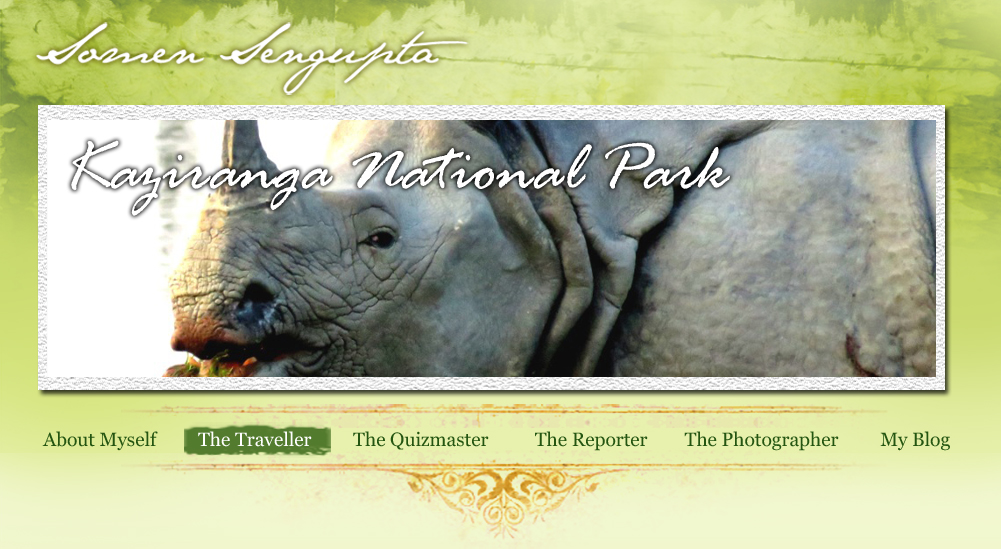| KAZIRANGA AN OPERA IN WILD & A SONATA IN SERENITY |
|
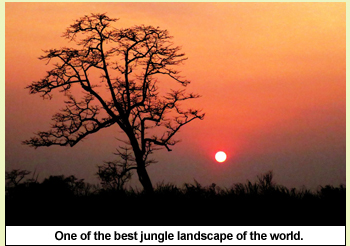 The inexplicable excitement of Kaziranga can only be compared with a live demonstration of Nat-Geo Wild channel watched with naked eyes. The world inside Kaziranga national park of Assam is mystic yet natural. It is because there she is bare, candid and bold in her display of secret. This is perhaps the only national park of India where a visitor does not need to put any effort to sight a wild life. The wild comes close to him and sometimes so close that one can even touch them by hands.
The inexplicable excitement of Kaziranga can only be compared with a live demonstration of Nat-Geo Wild channel watched with naked eyes. The world inside Kaziranga national park of Assam is mystic yet natural. It is because there she is bare, candid and bold in her display of secret. This is perhaps the only national park of India where a visitor does not need to put any effort to sight a wild life. The wild comes close to him and sometimes so close that one can even touch them by hands.
Likearunning motion picture panorama and astonishment of Kaziranga changesin a preset order. If one rhino passes you from the left, then they very next moment you can find a hornbill watching you from the woods. In one blink if you find a group of Assam roof turtles taking a sun bath beside a lake, then in next very moment a herd of Asian elephants can cross your beaten path.
It is hard to believe now that this national park of Assam an UNESCO world heritage sight was once about to vanish and then had a rebirth like a phoenix from ashes. Today Kaziranga is not only bouncing back as a huge national park, it is also cementing itself as one of the best example of the world to show how care and awareness can do magic in India.
The splendid NH-37 runs infront of the park from Guwahati to Jorhat. On it’s left side near the borrow pit of the road rhinos, elephants, deer and wild water buffaloes often stand. They come so close that one can take selfie with them though the same is strictly not recommended. If this is what one can see from outside imagine what thrill Kaziranga holds inside of her womb.
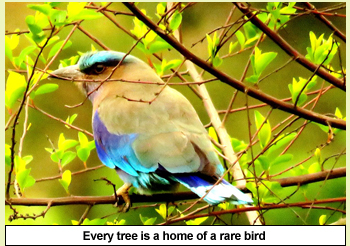 We Indians can hate Lord George Curzon for many reasons but this nation will ever be indebted to this legendary ruler for protecting and preserving several Indian monuments including Taj Mahal and Konark temple from their dilapidation. We Indians can hate Lord George Curzon for many reasons but this nation will ever be indebted to this legendary ruler for protecting and preserving several Indian monuments including Taj Mahal and Konark temple from their dilapidation.
The contribution of Curzon is not limited to these historical monuments alone. In 1903, after spending three long days when his American wife Mary Victoria Leiter could notsee a single rhinoceros in wild, she pressed the panic button and persuaded her husband to save Kaziranga. Curzon, unlike our present leaders, acted promptly.
On 1st June 1903 it was announced as reserve forest with 232 sq km of area which later on expanded to 480 sq km, that is more than double in size. In 1916 it was declared as game sanctuary but wanton killing of animals forced AJW Milory and PD Stracey, two environment enthusiasts, to fight against any kind of killing and thanks to their efforts from 1968 it was declared a national park, perhaps the most exceptional and extraordinary national park India ever had.
The exceptional feature of Kaziranga is visible in its magical landscape where three different faces of a forest viz woodland, wet land and grazing land co-exist side by side. It is a flat expansion of fertile alluvial soil formed out of erosion and silt deposition. The landscape is where the spectacular wildlife exists covered with sabanas, tall elephant grass, cane, riverines, flood formed lakes and some small elevated mounds.
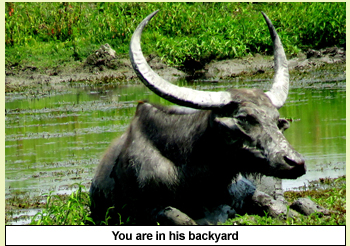 More than 5% of its surface area is covered by water-bodies. The park is circumscribed with mighty Bramhaputra river that flows inside the park like a king. Otherriverines like Dhansiri, Diplu and Mora also make their presence felt in the park. Bramhaputra flows on the north side of the park. Almost every year backflow of its water submerges the forest. However it is now proven that this flood helps to maintain a healthy bio-diversity balance of this park by recharging its water land, filled all lakes with fish stock, make the land fertile with its silts and clears its debris. More than 5% of its surface area is covered by water-bodies. The park is circumscribed with mighty Bramhaputra river that flows inside the park like a king. Otherriverines like Dhansiri, Diplu and Mora also make their presence felt in the park. Bramhaputra flows on the north side of the park. Almost every year backflow of its water submerges the forest. However it is now proven that this flood helps to maintain a healthy bio-diversity balance of this park by recharging its water land, filled all lakes with fish stock, make the land fertile with its silts and clears its debris.
Though it kills several animal in one hand, it also ensures a perfect healthy ecology on the other. Kaziranga is often referred as play ground of big five of Indian wild life family. All these free roaming primates coexist here in a negotiated peace. It is here all big five such as Royal Bengal Tiger, Indian unicorn rhinoceros, Indian elephants, Indian water buffalo and swamp deer are visible in abundance. Unbelievable it may sound but fact remains that in Kaziranga 70% of world’s rhinoceros are found.
In 2006 they counted as many as 1855,anumber that can surely make Lady Curzon smile in her grave. Assam has maximum number of elephants in India and Kaziranga itself houses 1206 of them out of 5500 plus. Indian water buffalo, the giant creature with massive horns are found in plenty here in Kaziranga and so are swamp deer with magnificent designed horns over their heads.
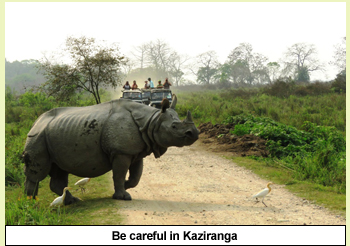 Aside of swamp deer, Kaziranga also had considerable number of hog deer, barking deer, sambar, gaur, wild boar, jungle cat, fishing cat, hispid hare, civet, Bengal fox, particoloured flying surrel, pangolin etc. Sighting rhinoceros in Kaziranga is almost like sighting a stray dog in an urban area. They are everywhere. They are in grazing land chewing the grass all the day as well as inside the lake taking a cool bath. Aside of swamp deer, Kaziranga also had considerable number of hog deer, barking deer, sambar, gaur, wild boar, jungle cat, fishing cat, hispid hare, civet, Bengal fox, particoloured flying surrel, pangolin etc. Sighting rhinoceros in Kaziranga is almost like sighting a stray dog in an urban area. They are everywhere. They are in grazing land chewing the grass all the day as well as inside the lake taking a cool bath.
It will be worth mentioning that this biggest home of rhino in world once used to house Javan rhinoceros now completely extinct. They ignore visitors mostly but in case of utter misfortune out of panic they may attack. Imagine a bundle of 2300 kg mass is pushing your jeep from front and there is a herd of elephants waiting to receive you at the edge !!!!! Kaziranga is the kingdom of the beast and it is best to be submissive in every step. Be careful with buffalo and elephants. They roam in groups where every cub is protected with ultimate care and any disturbance or threat in any form can prove fatal.
Animals crossing the beaten track is very common here and one needs to be careful in those moments. Any mess up with them to whom Kaziranga actually belongs may convert intoadeadly encounter. So play your role with dignity if you are inside of such a place. Tiger sighting is not easy in Kaziranga, though the park has a dense population of them. In the year 2000 animal census found 86 numbers of full grown tigers here, that makes 0.2 tiger/sq km an amazing proportion.
Tiger is mostly found near lakes and woodlands. They often take position in deep elephant grass making the task of spotting extremely difficult, but their smell and other signals like deer barking or an excitement among birds and monkeys on the branches often create a chilling impact on visitors. 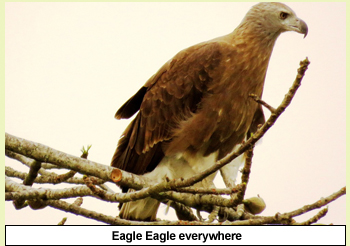 Being an isolated animal, a tiger is very much unpredictable. In Kaziranga tiger often comes out of the park and roams in the tea gardens. Every tourist wants to watch a tiger in Kaziranga and often behaves crazy once it is sighted. Needless to say this kind of overenthusiasm invites fatal trouble in wild. Outside Africa this is perhaps the only place where three big cats viz Royal Bengal Tiger, leopard and Himalayan clouded leopard are found in their natural breeding ground. Being an isolated animal, a tiger is very much unpredictable. In Kaziranga tiger often comes out of the park and roams in the tea gardens. Every tourist wants to watch a tiger in Kaziranga and often behaves crazy once it is sighted. Needless to say this kind of overenthusiasm invites fatal trouble in wild. Outside Africa this is perhaps the only place where three big cats viz Royal Bengal Tiger, leopard and Himalayan clouded leopard are found in their natural breeding ground.
This is also one of the biggest theatre of birds in the world. More than 478 species of birds are often sighted here. Out of that 25 are globally threatened and 21 are near threatened. No wonder that apart from its crown of UNESCO world heritage site won in 1985, Kaziranga has also owned another crown named Important Bird Area ( IBA) by Birdlife International for an enriched avifaunal species. Apart from elegant pelicans and hornbills,sky of Kaziranga is crowded with rosering parakeet, serpent eagle, Bengal florican, bald headed geese, jungle fowl, whistling teal, dalmation pelican, black neck stock, and many more.
Almost in every tree and near all lakes you can notice a rare eagle or an amazing colourful bird. For a birdwatcher this is a goldmine. Asamark of healthy ecosystem the park contains many raptors like eastern imperial eagle, white tailed eagle, greater spotted eagle etc. Once this was a home for huge number of vultures but an epidemic in last few years have wiped out 99% of them. Still rare vultures like red headed, Eurasian black and very rare slender billed vultures are found here. The park has three zones and it is better to map that before you go out for a safari. Kohora is the central zone where animal sighting is reported maximum. Here wild world of Assam unfolds likeafresh lotus bud. Plenty of rhinoceros, elephants, deer and ground monitor lizard roam in this zone whereas trees and lakes are full of pelicans, eagles etc.
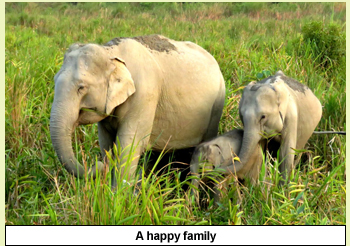 This part of the park has both grazing land and woods. One should not miss to spot array of Assam roofed turtle taking sunbath on dead woods in a line like a company of disciplined soldiers. This is one of the signature sights of Kaziranga. Kohora is best explored from afternoon to sundown. 21 km from Kohora another entry gate named Agratoli is like another door of magic world.This eastern part of the park adjacent to tea gardens is full of water bodies, woodlands and grassland. Apart from a pelican colony the bank of Bramhaputra is also here.Acareful watching from this bank can show you Gangetic dolphins in the river. Chance of sighting tiger is very high and so are rhino and water buffaloes. This part of the park has both grazing land and woods. One should not miss to spot array of Assam roofed turtle taking sunbath on dead woods in a line like a company of disciplined soldiers. This is one of the signature sights of Kaziranga. Kohora is best explored from afternoon to sundown. 21 km from Kohora another entry gate named Agratoli is like another door of magic world.This eastern part of the park adjacent to tea gardens is full of water bodies, woodlands and grassland. Apart from a pelican colony the bank of Bramhaputra is also here.Acareful watching from this bank can show you Gangetic dolphins in the river. Chance of sighting tiger is very high and so are rhino and water buffaloes.
The famous YouTube video of Kaziranga tiger attacking elephant was taken in a tea garden adjacent to this zone only. Bagori is another gate of Kaziranga and an equally enriched zone. As usual, this part is also full of rhinos and elephants. Here roads are dusty and often crossed by any of the big five creatures of Kaziranga. One more entry point, not that popular, is Panbari where hoolock gibbons, the only ape found in India and cat langurs are often sighted. In local language Kaziranga means where mountain goats have water but legend has also generated a love story between a boy named Kazi and a girl named Ranga.
It is believed that when their relation was not sanctioned by the society one day they entered the jungle by holding their hands only to vanish inside forever. Thus the forest is named after them. Like that legend the story of Kaziranga’s emergence from a near extinct condition in 1903 to one of the top national parks of the world is nowamatter of pride and discussion across the world. No other jungle of India hasthis much interestspectrum and history as Kaziranga contains. Thusin our memories and in ourspirit of humanity that teaches us for peaceful coexistence with nature Kaziranga lights up likeabright flame of a burning torch.
This article was published in The Hitavada on 14th January 2018
Click here to view the original article
|
